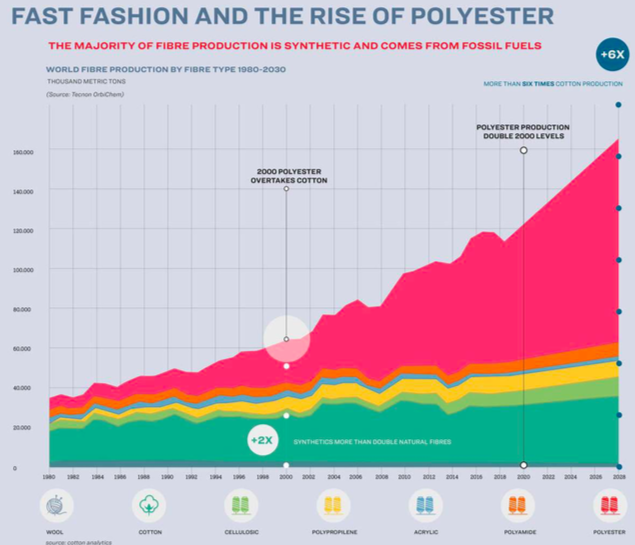The hidden reliance of fast fashion on fossil fuels - new report out
Here comes a summery of the report:
Since 2000, fashion production has doubled. The volume has increased from 62 million tonnes in 2015 to 102 million tonnes by 2030, representing $3.3 trillion in value. The increase in demand comes from more people being able to afford cheap fashion but mostly more people buying larger volumes, use clothes less often and by creating huge piles of textiles waste. The average consumer buys 60% more clothing compared to 15 years ago
The cheap fast fashion clothes are enabled due to synthetic fibres, mostly polyester, found in half of all the textile products. This report claims that the growth in chip fibre is correlated with the growth of fast fashion.
Production of polyester has grown ninefold in the past 50 years. Polyester is cheaper than cotton, only half the price per kilo. It is also material that is mixed and blended into other materials such as cotton creating another set of problems when it comes to waste management.
Production of cheap synthetic fibres not only enables low-quality clothes – it also makes the fashion industry highly dependent on continued fossil-fuel extraction, the report says. The production of synthetic fibres for the textile industry currently accounts for 1.35% of global oil consumption. This exceeds the annual oil consumption of Spain.
And the demand is increasing where synthetic textiles will grow from 69% to 73% of total production globally by 2030. In other words, if the fashion industry continues with business as usual, in less than 10 years, almost three-quarters of our textiles will be produced from fossil fuels.
In 2015, polyester production for textiles alone was responsible for emissions of over 700 million tonnes of carbon dioxide (CO2) equivalent –similar to the annual greenhouse gas (GHG) emissions of Mexico or 180 coal- red power plants. This is projected to nearly double by 2030, reaching twice the GHG emissions of Australia. If these expansion plans go ahead, the textile sector’s emissions could grow rapidly and undermine the climate commitments of fashion brands.
Recycling will not solve fast fashion’s problems, nor will it curb the exponential growth in the use of synthetic. Currently, less than 1% of clothes are recycled to make new clothes, and the share of recycled polyester is declining; while it accounted for 14% in 2019, this will in fact decrease to 7.9% of overall polyester production by 2030. Furthermore, virtually all recycled polyester in clothing comes not from recycled garments, but from recycled plastic bottles. Legislation and voluntary commitments by consumer goods companies means there will be more competition for recycled PET. With limited options for viable bre-to- bre polyester recycling, atthe end of its life this polyester will be sent to land ll or burnt. Turning polyethylene terephthalate (PET) bottles into recycled polyester therefore represents a one-way ticket to disposal, while this material should instead remain in a closed-loop bottle-to-bottle recycling system.
Recycling also does nothing to solve a problem both microscopic and enormous: micro plastics. Micro plastic are found throughout ocean ecosystems, with a recent study discovering that 73% of micro plastic pollution in formerly pristine Arctic waters is from synthetic fibres that could be coming from textiles.
It is clear that fast fashion are a climate change driver and that despite all the good sustinable business models and initiatives, we’re heading the wrong direction. Legislation is required, new business models needed and consumer behaviour needs to change.
Read the full report here where you can also find some suggestions for solutions!







